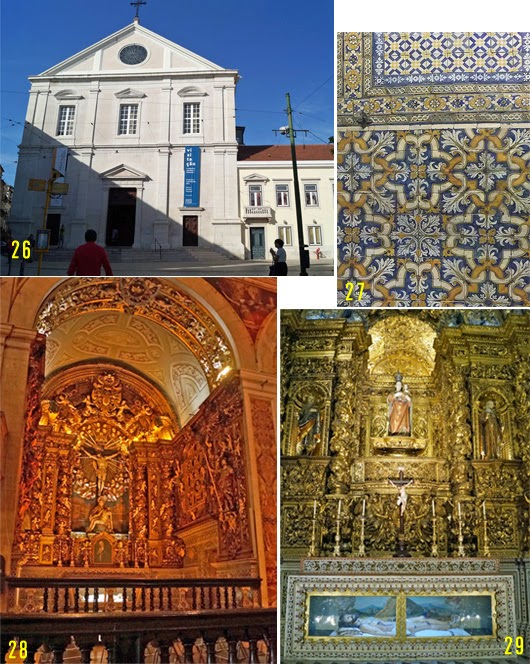スペインとポルトガルを巡る旅 22: リスボン2、町歩き、8日目、10月19日
< 1. a view from Largo
das Portas do Sol >
< 1.ポルタス・ド・ソル広場からの眺め >
Today, I introduce
the first half of walking around town that we conjugally enjoyed in Lisbon
center.
It are Electrico (streetcar),
Elevador (cable car), observation decks, a church, lunch , and troubles.
今日は、リスボン中心部を夫婦で楽しんだ町歩きの前半を紹介します。
市電、ケーブルカー、展望台、教会、昼食、さらにトラブルを紹介します。
< 2. a map of Lisbon
center >
< 2. リスボン中心部の地図 >
The number in the map is
it of the photo, and is in order of the photography.
地図中の数字は写真の番号で、撮影の順番になっている。
< 3. the scenery from
our hotel to Belem >
< 3. ホテルからベレンまでの景観 >
We left Oriente Station neighborhood by
bus at 9:00 a.m. and arrived at Belem 30 minutes later.
The photos 1-4 are it
from my bus.
1: Rio Tejo. Ponte
Vasco da Gama(Bridge) of 17km in total length is seen on the left side subtly.
2: Rossio railway
station in the edge of Rossio Square. The inside of it is big.
3: The monument of
Restauradores Square.
4: I saw a new
town on the way from the city center to Belem.
5: I look at Ponte
25 de Abril (bridge) from Belem. Its name was renamed in commemoration of a
revolution day.
朝9時にオリエンテ駅近くをバスで出発し、30分後にベレンに到着した。
写真1~4まではバスからの写真です。
1: テージョ川。左側に微かに全長17kmのヴァスコ・ダ・ガマ橋が見える。
2: ロシオ広場の端にあるロシオ駅。内部は大きな鉄道の駅。
3: レスタウラドレス広場のオベリスク。
4: 市中心部からベレンへ抜ける途中の新市街。
5: ベレンから4月25日橋を見る。革命日を記念して改称された。
We begin walking
around town
After sightseeing in Belem, the person
who wants to act freely was got a lift on bus to Rossio Square.
We purchased one daily
ticket of Carris in Rossio Square.
This is very convenient,
because one person can get free on streetcar, cable car and subway with this
ticket.
町歩きを始める
ベレン観光後、自由行動する人は、バスでロシオ広場まで送ってもらいました。
私達は、ロシオ広場でカリスの1日券を購入した。
この券で市電、ケーブルカー、地下鉄などが乗り放題で、非常に便利です。
< 4. we get on
streetcar >
< 4. 市電に乗る >
6: Figueira Square
From the station of the south side of
this square, we got on a streetcar of track No. 12, and went to Largo das
Portas do Sol.
An accident happened
here
When I got on the streetcar through the
crowd, several women suddenly pressed like a sandwich me.
As I wondered about it, I tried to put
my hand up my waist pouch, and I touched someone's hand.
In the streetcar, I
heard a clicking of a woman nearby, and three women got off at the next stop.
It was in imminent
danger.
Everybody, please be
careful about a pickpocket and a luggage thief.
7-8: These are
photographed by a streetcar.
9: I got it off in
Largo das Portas do Sol.
6: フィゲイラ広場。
この広場の南側の停留所から、12番線の市電に乗り、ポルタス・ド・ソル広場に行く。
ここで事件が起きた
混雑している中、市電に乗ろうとしたら、急に数人の女性が私を挟むように圧迫した。
不思議に思い、ウエストポーチに手をやると、誰かの手に触れた。
市電の中で、近くの女性が舌打ちする音が聞こえ、次の停留所でその三人の女性が下車した。
危機一髪でした。
皆さんもスリや置き引きに気をつけて下さい。
7、8: 市電から撮影。
9: ポルタス・ド・ソル広場で降車。
< 5. views from Largo
das Portas do Sol >
< 5.ポルタス・ド・ソル広場からの眺め >
10: Largo das Portas do Sol.
11-12:
views from Largo das Portas do Sol.
I could see Rio Tejo and Alfama district
below my eyes.
It was fine and I was
really refreshing.
Alfama district had little damage by
Lisbon great earthquake (1755), and very old streets are remaining.
10: ポルタス・ド・ソル広場
11、12: ポルタス・ド・ソル広場からの眺め。
テージョ川とアルファマ地区が眼下に見える。
天気が良くて、実に爽快だった。
アルファマ地区はリスボン大震災(1755年)の被害が少なく、非常に古い街並みが残っている。
< 6. from Largo das
Portas do Sol to Castelo de Sao Jorge >
< 6.ポルタス・ド・ソル広場からサン・ジョルジェ城まで >
14: a way on the
way to Castelo de Sao Jorge.
15: The entrance of
the castle.
The admission ticket was
being sold just before this, but I disliked standing in line waiting for it, and we didn’t enter it.
This castle began in the Roman era, and
the severe battle was fought on here in Reconquista.
The view from here is
the best in this city.
16:
we have lunch at a nearby restaurant.
17: we ordered a fish tapas and a meat tapas.
These tapas were much
quantity and very saltiness, and we left it considerably.
While looking at
neighboring patrons in the restaurant, they put plenty olive oil, vinegar, and
mayonnaise on the dish, and ate.
It seems different from the taste of the
dish of my tour.
14: 途中の道。
15: 城の入口。
この手前で入場券を販売していたが並ぶの嫌で、入城しなかった。
この城はローマ時代に始まり、レコンキスタでは激戦が繰り広げられた。
ここは市内随一の眺望が望める。
16: すぐ近くのレストランで昼食をとる。
17: 魚のタパスと肉のタパスを注文した。
料理の量が多く、すべて塩味が強く、かなり残すことになった。
周囲の客を見ていると、料理にオリーブオイルやビネガー、マヨネーズをたっぷりかけて食べていた。
ツアーで食べる料理の味とは異なるようだ。
ここでもトラブル発生
看板の写真を指して注文したはずだったが、行き違いがあった。
支払い時、請求額は予想の倍になり、現金のユーロが足らずカードも使えなかった。
店主が近くのATCまで付いて来て、そこで現金を下ろし支払った。
店員とは英語が通じず、適当にやっていて冷や汗をかいた。
< 7. Baixa district >
<7.
バイシャ地区 >
From Largo das Portas do
Sol, we got on a streetcar of same track No. 12, and got off at Baixa district.
18: inside of a streetcar.
19-20: Baixa district.
21:
Elevador de Santa Justa.
At first, we stood in line waiting for
it, the progress was no further, and so we stopped riding on it.
ポルタス・ド・ソル広場から同じ12番線の市電を乗り、バイシャ地区で降りた。
18: 市電内部。
19、20: バイシャ地区。
21: サンタ・ジュスタのエレベーター。
最初、行列で並んだが、一向に進まないので、乗るのを止めた。
< 8. we get on a cable
car >
<8.
ケーブルカーに乗る >
We went through Rossio Square,
and got on a cable car of Gloria in Restauradores Square.
23-24: photos from the lower station and the upper station.
25:
Miradouro de Sao Pedro de Alcantara.
私達はロシオ広場を抜け、レスタウラドレス広場にあるグロリア線のケーブルカーに乗る。
23、24: 下駅からと上駅から撮影。
25: サン・ペドロ・デ・アルカンタラ展望台。
< 9. a view of Castelo
de Sao Jorge from Miradouro de Sao Pedro de Alcantara >
<9.
サン・ペドロ・デ・アルカンタラ展望台からのサン・ジョルジエ城 >
< 10. Igreja de Sao
Roque >
<10. サン・ロケ教会 >
This church had been
full of solemnity, but I couldn’t imagine it from the outward appearance.
This church was a base of the Society of
Jesus, so Tenshō embassy from Japan stayed for about 1 month here.
26:
Front entrance. It collapsed by an earthquake and was rebuilt.
30:
This church was a baroque building built at the end of 16th century, but
the wall surface was decorated by Mudejar tile.
外観からは想像も出来ない荘厳さに満ちた教会でした。
この教会はイエズス会の拠点だったので、天正遣欧少年使節団はここに1ヶ月ほど滞在している。
26: 正面入口。地震で倒壊し再建された。
30: この教会は16世紀末に建てられたバロック建築だが、壁面はムデハル様式のタイルで装飾されていた。
< 11. Chapel of Igreja
de Sao Roque >
<11. サン・ロケ教会の礼拝堂(奥正面) >
On the next time, I introduce the latter half of walking
around town in Lisbon.
次回は、リスボン町歩きの後半を紹介します。

























